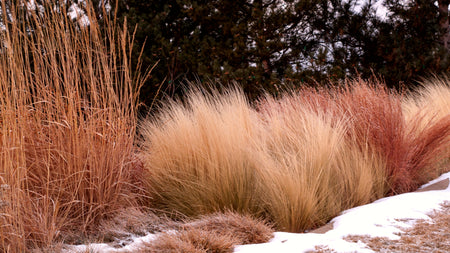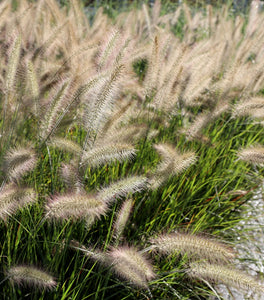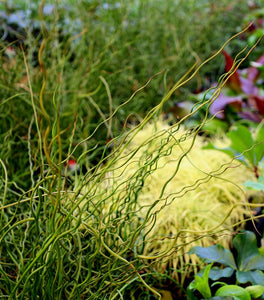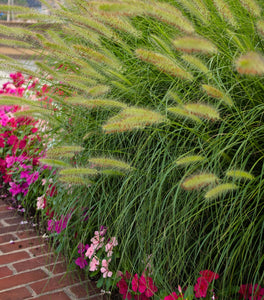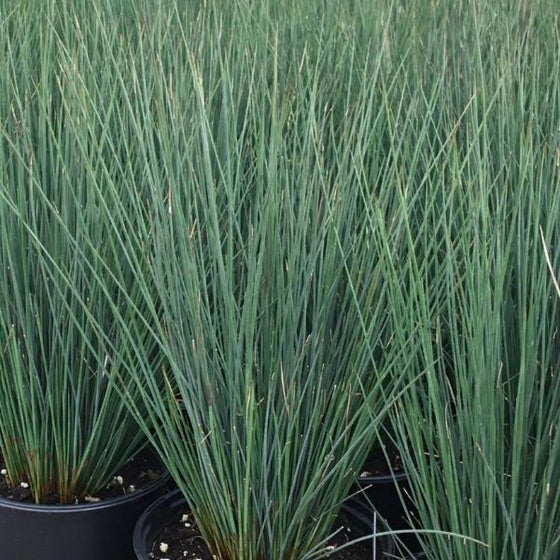
Images Depict Mature Plants
Juncus Blue Arrow For Sale Online
Juncus Blue Arrow (Juncus inflexus 'Blue Arrow') is a striking ornamental grass known for its upright, stiff, blue-green stems that add bold texture and structure to any garden or landscape. This clump-forming plant grows in a distinct vertical pattern, reaching a mature height of 24-36 inches and a spread of 12-18 inches. The unique blue-gray hue of its foliage creates an eye-catching contrast with other plants, making it an excellent focal point in mixed beds, borders, or water gardens. Ideal for adding both height and texture, Juncus Blue Arrow thrives in wet, boggy conditions and can be used to enhance the natural beauty of ponds, streams, or rain gardens.
Hardy in USDA Zones 5-9, Juncus Blue Arrow prefers full sun to partial shade and consistently moist to wet soils. It is an excellent choice for water-wise gardens or areas with poor drainage, as it can tolerate standing water and soggy soil. This plant is also well-suited for container gardens, where its striking upright form and vibrant blue-green color provide year-round interest. While Juncus Blue Arrow can handle periods of drought once established, it performs best in areas with regular access to water, making it perfect for rain gardens or water features.
In addition to its ornamental appeal, Juncus Blue Arrow is low-maintenance and deer-resistant, making it a reliable option for gardens where wildlife browsing is an issue. Its dense, upright growth habit helps with erosion control in areas prone to water runoff or soil erosion, adding both beauty and functionality to the landscape. Whether used as a bold accent in perennial beds, along the edges of water features, or in mixed planters, Juncus Blue Arrow brings year-round texture, color, and resilience to your garden design.
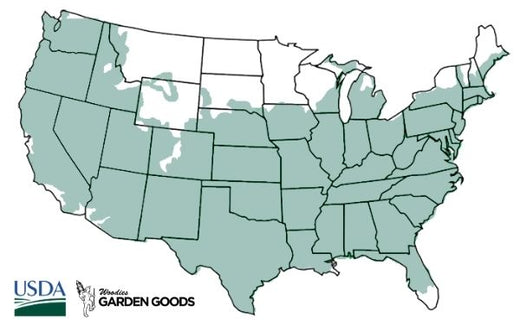
| Hardiness Zone: | 5-9 |
|---|---|
| Mature Height: | 18 to 24 Inches |
| Mature Width: | 12 to 18 Inches |
| Sunlight: | Full Sun to partial shade, bright indirect light to filtered indirect light |
| Water Requirements: | Likes to stay evenly moist |
| Flower: | Inconspicuous |
| Foliage: | Round blades, blue-green color |
| Growth Rate: | Medium to fast |
| Uses: | Indoor an outdoor; container gardens; rock gardens; ornamental indoor plant; specimen |
How to Care for Juncus Blue Arrow
Before buying your new Juncus Blue Arrow Plants, make sure to read the recommended care instructions
How do I Plant Juncus Blue Arrow?
To plant Juncus Blue Arrow, begin by selecting a location with full sun to partial shade and consistently moist to wet soil, as this ornamental grass thrives in damp conditions. It’s ideal for rain gardens, boggy areas, and around water features like ponds or streams. Start by digging a hole twice the width of the plant's root ball and deep enough so the top of the root ball is level with the soil surface. Gently loosen the roots before placing the plant in the hole, then backfill with soil, pressing down firmly to eliminate any air pockets. After planting, water thoroughly to help the plant establish strong roots. For best results, space multiple Juncus Blue Arrow plants 12-18 inches apart to allow for their upright, clumping growth habit. If planting in containers, choose a pot with good drainage and use a rich, well-draining potting mix that retains moisture. This plant performs best in wet to consistently moist soil, so be sure to water regularly, especially during the first growing season. Mulching around the base of the plant can help retain moisture and suppress weeds. With proper planting and care, Juncus Blue Arrow will thrive, adding its bold, vertical blue-green stems and striking texture to your landscape or container garden.
How Do I Water my Juncus Blue Arrow?
To water your Juncus Blue Arrow, it’s important to maintain consistently moist to wet soil, as this ornamental grass thrives in damp environments. During the first growing season, water deeply and regularly to help establish a strong root system, ensuring the soil remains consistently moist but not waterlogged. Juncus Blue Arrow is ideal for wet areas such as rain gardens, boggy spots, or around water features, so it can handle standing water without any issues. If planted in containers, check the soil often and keep it evenly moist, especially in hot or dry conditions. Once Juncus Blue Arrow is established, it becomes somewhat drought-tolerant, but it still performs best when given regular access to water. Continue to water deeply during dry spells, ensuring the soil remains moist to help the plant retain its vibrant blue-green color and upright growth habit. For plants in wet areas like ponds or streams, natural water sources may provide adequate moisture, but supplemental watering can be necessary in extremely dry conditions. By maintaining a consistent watering schedule, Juncus Blue Arrow will thrive, offering year-round texture and beauty in your garden.
How Do I Fertilize my Juncus Blue Arrow?
To fertilize your Juncus Blue Arrow, apply a balanced, slow-release fertilizer in early spring to support healthy growth and vibrant blue-green foliage. A fertilizer with a 10-10-10 formula will provide essential nutrients such as nitrogen, phosphorus, and potassium to promote strong root development and lush growth. Spread the fertilizer evenly around the base of the plant, taking care to avoid direct contact with the foliage, and water thoroughly after application to help the nutrients reach the roots. For a more organic approach, you can also apply compost or well-rotted manure, which will enrich the soil over time and enhance the plant’s performance. Once Juncus Blue Arrow is established, it generally requires minimal fertilization, especially if planted in rich, organic soils. A light top-dressing of compost or a mild fertilizer in early spring should be sufficient to maintain its health. Avoid over-fertilizing, as this can lead to overly lush growth that may compromise the plant's structural integrity. For container plantings, a liquid fertilizer applied every few months during the growing season can help maintain the plant’s vigor. By following a light and balanced fertilization routine, your Juncus Blue Arrow will continue to thrive, offering bold texture and upright growth in water gardens, borders, or containers.

How Do I Prune My Juncus Blue Arrow?
To prune your Juncus Blue Arrow, the best time is in late winter or early spring, just before new growth begins. Use sharp pruning shears to cut away any dead, damaged, or discolored stems at the base of the plant. Removing these old stems encourages fresh, healthy growth and maintains the plant's upright, structured appearance. Since Juncus Blue Arrow is a clump-forming grass, regular pruning of dead or weakened foliage helps keep the plant tidy and reduces the risk of disease or pest issues. During the growing season, Juncus Blue Arrow typically requires minimal pruning, as it maintains its tidy, upright shape. However, if you notice any broken or misshapen stems, you can trim them as needed to keep the plant looking its best. For container plantings, pruning helps manage the size and keeps the plant looking neat and vibrant. Avoid heavy pruning during the active growing season to prevent stress on the plant. By pruning regularly and removing dead growth, Juncus Blue Arrow will continue to thrive, showcasing its bold, vertical blue-green stems in your landscape or container garden.








